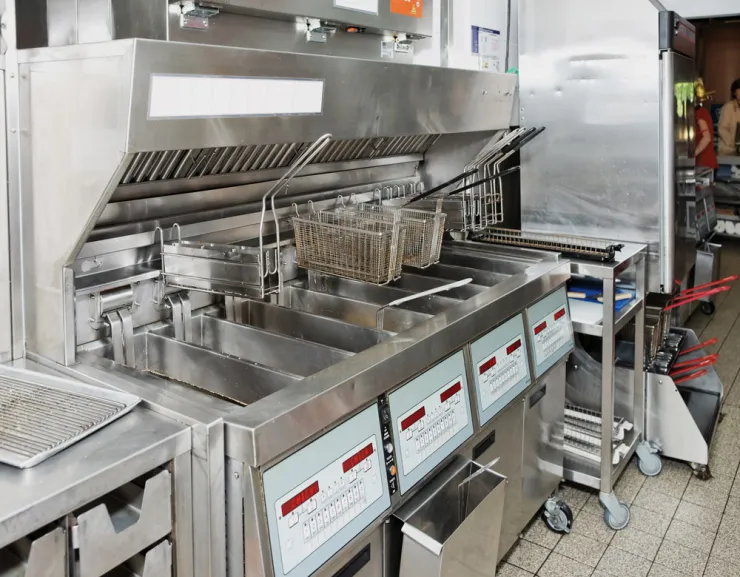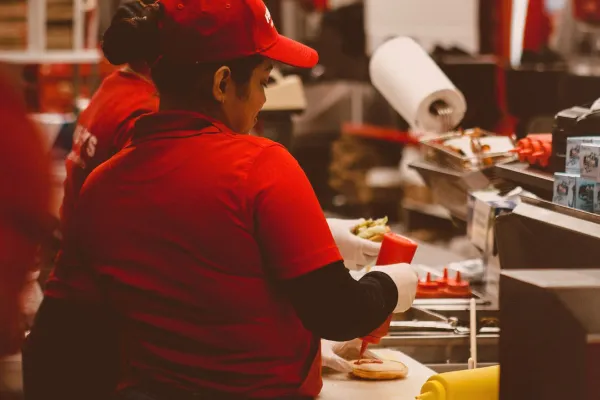
Running fast food restaurants can be a rewarding and lucrative business, but it’s not without its challenges.
There’s a huge amount of demand and opportunity in the industry, which topped $800 billion in 2022. But it’s also fiercely competitive.
In this guide, we will cover the key aspects of running a fast food restaurant, from setting it up and choosing a location to menu planning and pricing, marketing and advertising. We’ll also cover key issues such as maintaining quality and customer satisfaction and managing finances and costs.
With the right planning and execution, you can create a successful fast food restaurant that serves delicious and convenient meals to happy customers. Whether you run an existing chain of quick service restaurants or are thinking about getting into the fast food game, here’s how to successfully manage fast food restaurants.
Below, we'll cover the fundamental of fast food restaurants, including:
- What is a fast food restaurant?
- What was the first fast food restaurant?
- Fast food restaurant names
- S
- Our step-by-step guide to managing fast food restaurants
- Fast food restaurant tech
What is a fast food restaurant?
A fast food restaurant, also known as a quick service restaurant, is one that serves quick, convenient, affordable food to customers. Fast food restaurants are characterised by efficient, repeatable processes, limited menus and consistent products across locations.
Food is typically ordered at the counter and served within minutes. Customers pay for their food when they order and then collect it to take away or eat in. Alternatively, modern fast food restaurants offer online ordering for collection or delivery, as well as other ordering methods like drive-through and self-ordering kiosks.
When people think of fast food restaurants, the big chains like McDonald’s, Burger King, KFC and Subway come to mind. But the category also includes independent takeaway restaurants, smaller regional chains and many other restaurants that serve affordable food quickly.
What was the first fast food restaurant?
The concept of fast food, or quick and convenient food service, has been around for centuries, but the modern fast food industry as we know it today was born in the United States in the early 20th century.
The first fast food restaurant is often credited to White Castle, which was founded in 1921 in Wichita, Kansas. White Castle's founders, Walter A. Anderson and Billy Ingram, revolutionised the food service industry by introducing the concept of the "slider" hamburger, a small, square-shaped burger that could be cooked quickly and served to customers in a matter of seconds.
White Castle's success led to the rapid expansion of fast food chains across the country, including McDonald's, Burger King and Taco Bell, which became household names in the decades that followed. Today, the fast food industry is a multibillion-dollar business that spans the globe, with countless chains and franchises serving up quick and convenient meals to millions of customers every day.
Fast food restaurant names: how to name your brand
Choosing the right fast food restaurant name is essential to give the right impression to your customers. And with more people ordering online, it’s important to choose a name that stands out in a list of options.
You can take inspiration for your name from your location, type of food, customers or anything else that means something to you and your brand.
Brands like Orginal Fry Up Material and The Codfather use clever wordplay to catch people’s attention. But inspiration might come from other sources and you might choose a name that simply sums up your offering. If you’re really stuck for ideas, try an online name generator to kick-start the creative process.
Overall, your name should tell potential customers what to expect and be memorable enough to stand out in today’s crowded digital marketplace.
6-step guide to managing fast food restaurants
If you’re creating a new fast food brand and restaurant from scratch or looking to brush up on your fast food restaurant management skills, here are the fundamentals to setting up and running fast food restaurants.
Setting up your fast food restaurant
Before you can start serving food, there are some very important tasks to take care of.
First, you need to decide what type of business model and strategy you will follow and create a fast food restaurant business plan. During this process, you will decide on your location, pricing, type of food and the necessary equipment and supplies, among many other key factors.

When selecting a location, it's important to consider factors such as the surrounding area, foot traffic and access to public transportation.
The design of your restaurant should be functional and aesthetically pleasing, with efficient workflow and adequate seating. Make sure you budget for all the equipment and supplies you need, such as kitchen equipment, food packaging, cleaning products and ingredients, as well as the software and hardware to power your ordering and restaurant management systems.
Finally, you need to hire and train a team of reliable and friendly staff to serve your customers. Putting in place a team that shares the values of your brand is the key to consistent quality and service at your restaurant.
For more detail on this complex topic, read our step-by-step guide to opening a restaurant.
Menu planning and pricing
One of the most important aspects of running a fast food restaurant is determining what to serve on the menu. Consider the tastes and preferences of your target audience, as well as any dietary restrictions and allergens.
You should also consider the cost of ingredients and the time it takes to prepare each menu item. Fast food customers expect to receive their food within minutes of ordering.
Once you have your menu items selected, you'll need to price them appropriately to ensure you are making a profit. Don't forget to include specials and promotions to keep things interesting and attract new customers.
Marketing and advertising
Effective marketing and advertising is crucial for the success of any business, including a fast food restaurant. There are many traditional techniques you can use, such as signage, flyers and local newspaper ads.
In today's digital age, however, it's also important to utilise digital marketing techniques like social media marketing, Google Ads and email and SMS marketing.
Owning your own ordering channels, such as a branded online ordering website and app, means you can drive traffic directly and not have to pay fees to delivery marketplaces.
Hire the right fast food manager
The success of a fast food restaurant isn’t just down to the food it serves, it’s also about consistency, maintaining quality and keeping staff happy and engaged.
Fast food managers are responsible for overseeing the day-to-day operations of the restaurant, ensuring that the food is of high quality, that customers are satisfied and that the staff are well-trained and motivated.
Hiring the right manager is therefore crucial, as they can make or break a fast food restaurant. A skilled and experienced manager can improve efficiency, reduce costs and increase profits.
Without a good manager, you’re likely to see low morale, poor customer service and a decline in sales. In short, the right fast food manager is the key to success in the fast food industry.
Maintaining quality and customer satisfaction
To keep customers coming back, it's important to maintain a high level of quality and customer satisfaction. This includes providing fast and efficient service, keeping the restaurant clean and organised and handling any customer complaints or issues in a timely and professional manner.

A restaurant management system, aka a restaurant POS system with added features and integrations, can help you automate tasks and ensure consistency. Using tools like food safety checklists, smart staff schedules and detailed reporting, you can automate tasks for a more efficient and regimented operation.
Regularly soliciting feedback from customers can help you identify areas for improvement and ensure you are meeting their needs.
Managing finances and costs
Effective financial management is crucial for the success of any business, and it's especially important in the fast food industry where margins can be tight. Set up a budget and track your income and expenses carefully.
Look for ways to reduce costs and increase profits, such as negotiating better prices with suppliers or streamlining your operations.
Fast food restaurant tech
With efficiency at the heart of their success, fast food restaurants are at the forefront of restaurant tech. The industry is often at the cutting edge of the latest ordering, payment and restaurant management technology.
Let’s take a look at the tech you might find in a fast food restaurant.
Fast food restaurant POS
The POS is the heart of modern restaurant tech systems. It is the terminal for employees to take orders and process payments, but also serves as the data centre and management hub for the restaurant.
With tools like inventory management, staff scheduling and kitchen management built-in to modern restaurant POS systems, they are becoming the core technology for modern fast food restaurants.
Fast food automated ordering system
Self-service kiosks and voice ordering at the drive-through are both examples of fast food automated ordering systems. Kiosks are becoming commonplace in the larger fast food chain restaurants, offering the benefits of a better customer ordering experience, lower staff costs and higher average order value.
Digital menu boards
Many fast food restaurants use digital menu boards to display their menus, meal deals and special offers. These programmable digital screens can also be used to encourage upsells and cross-sells and display advertising or restaurant branding.
Customer display system (CDS)
A customer display screen is similar to the digital menu boards but it is connected to the POS system, enabling it to display real-time customer order information. It can let the customer know their order status and when it is ready for collection, keeping them in the loop as they wait.
Kitchen display system (KDS)
The KDS is the hub of kitchen operations, taking in orders from the POS, categorising them and displaying them clearly to the relevant kitchen stations.
With colour-coded orders and the option to print labels at each station, a KDS is vital to stay organised and avoid errors in a busy fast food kitchen.
Online ordering websites and mobile apps
Modern fast food restaurants want to make it as easy as possible for customers to place an order. Many restaurants have their own ordering apps that sit right on their customers' phones. Or online ordering websites where customers can place orders and store information for next time.
Having your own branded site or app means you avoid the high fees of delivery marketplaces. Plus, you own the customer data, which you can use to re-target customers and build loyalty for future growth.
Run a more profitable and efficient fast food restaurant
In this guide, we've covered the key aspects of running fast food restaurants, including setting it up, menu planning and pricing, marketing and advertising, maintaining quality and customer satisfaction and managing finances and costs.
With the right planning and execution, you have the exciting opportunity to create a successful and profitable fast food establishment that serves delicious and convenient meals to delighted customers. If you're aspiring to open a fast food restaurant, we hope this guide has provided a dose of the realities of fast food restaurant management, while also being helpful and encouraging.


